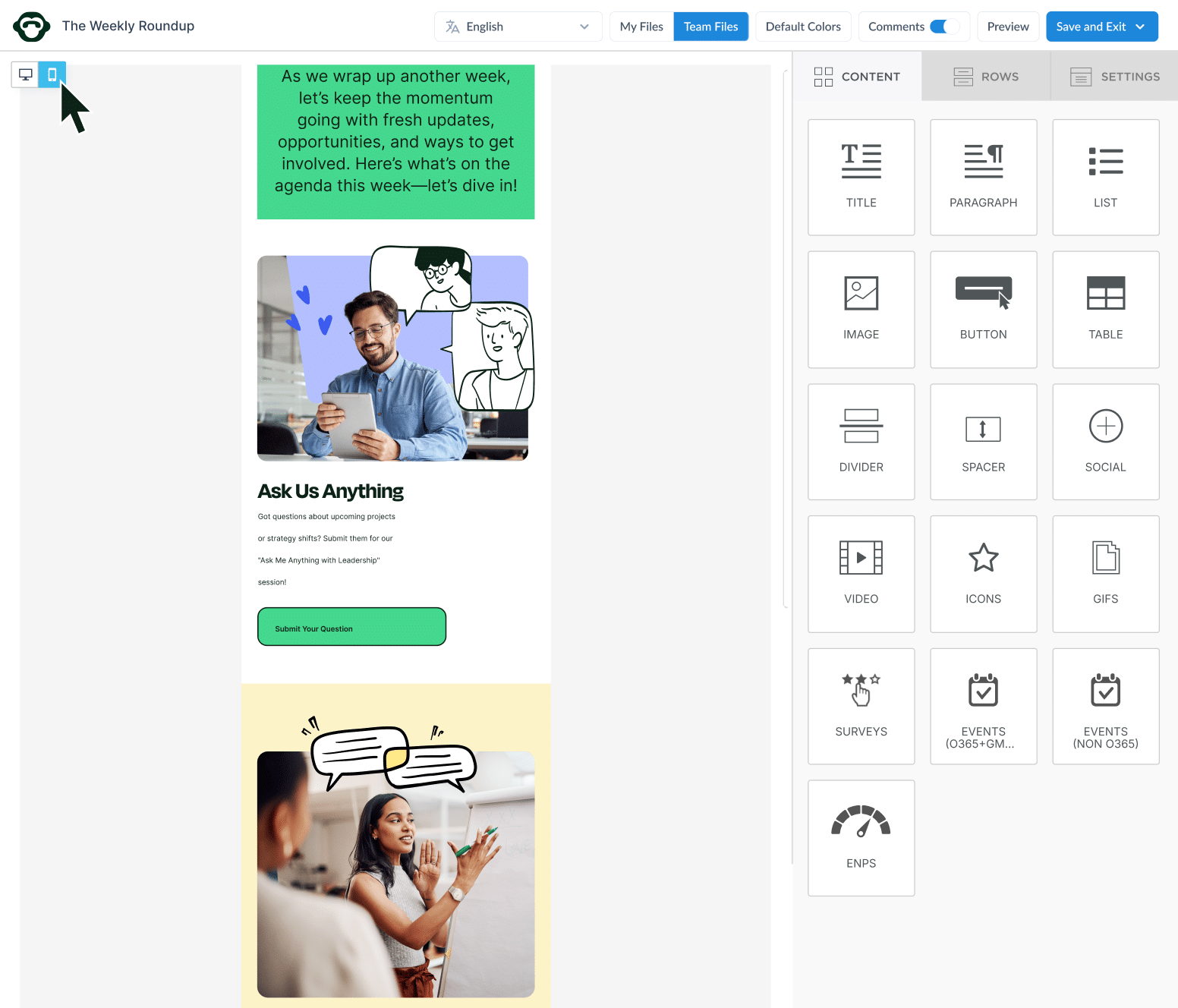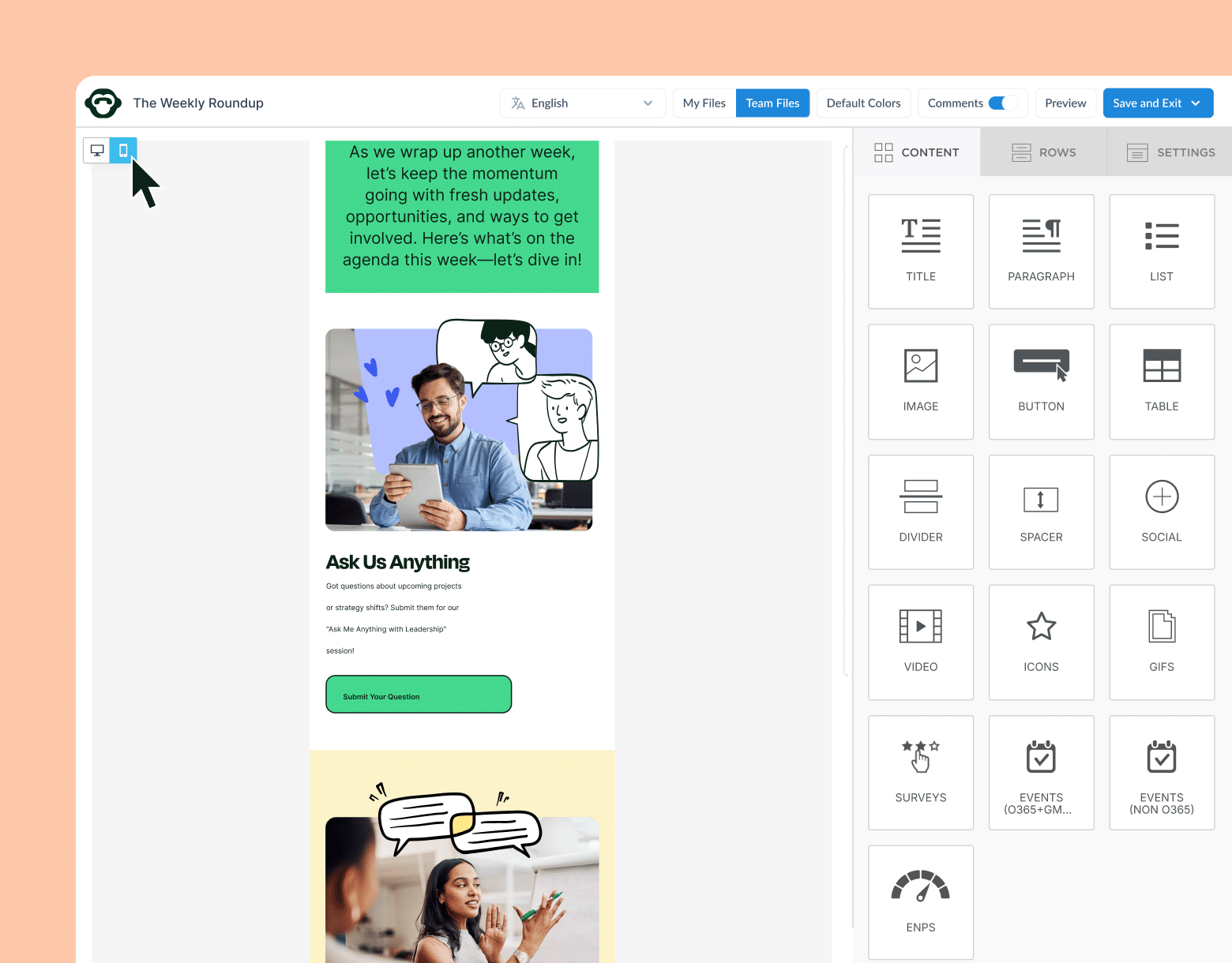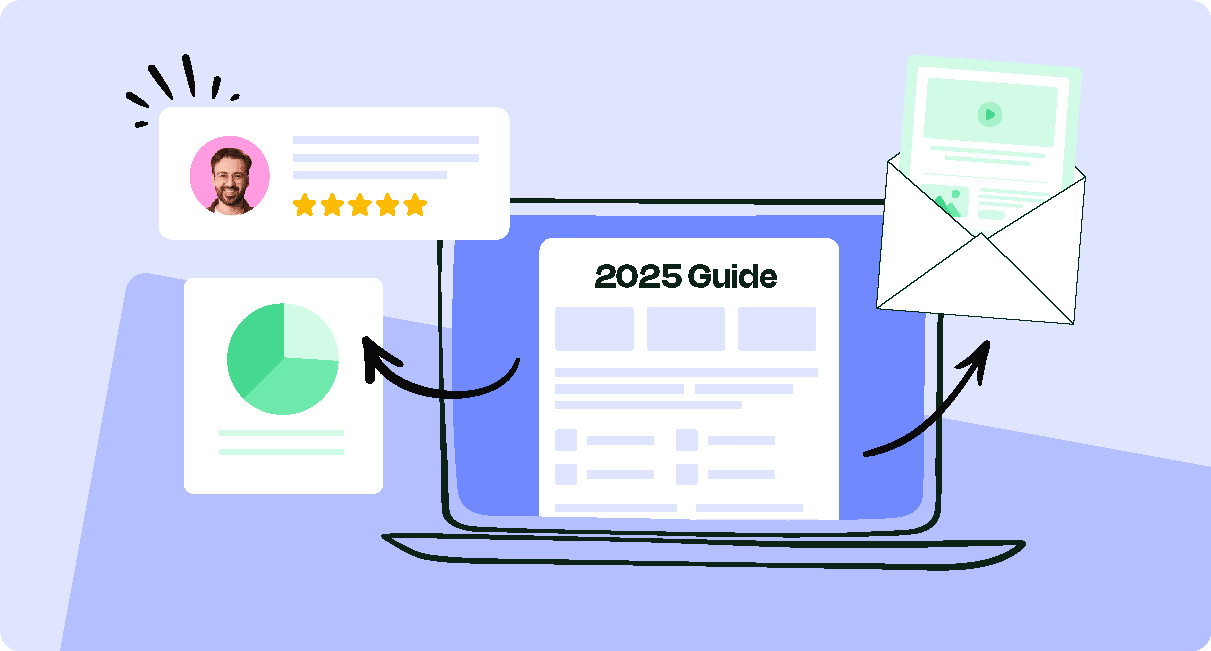Can you make someone care about something they don’t care about? Not exactly. But you can create the conditions that make it easier for them to start caring. These 15 employee engagement best practices are designed to help you achieve this through actionable tips.
Employees care when they feel connected—when their work aligns with their values, identity, or purpose. That’s why effective employee engagement isn’t about convincing people to care out of obligation. It’s about helping them see themselves in the work.
You can’t manufacture motivation but you can uncover it, nurture it, and remove the blockers that get in its way. That’s what the best leaders and internal communicators do. They don’t shout louder. They listen better.
The 15 employee engagement best practices you’ll find here are designed to help you move your people toward purpose, connection, and showing up fully at work.
Take a self-guided tour of ContactMonkey
See how our key features can streamline your internal communications.
Take product tour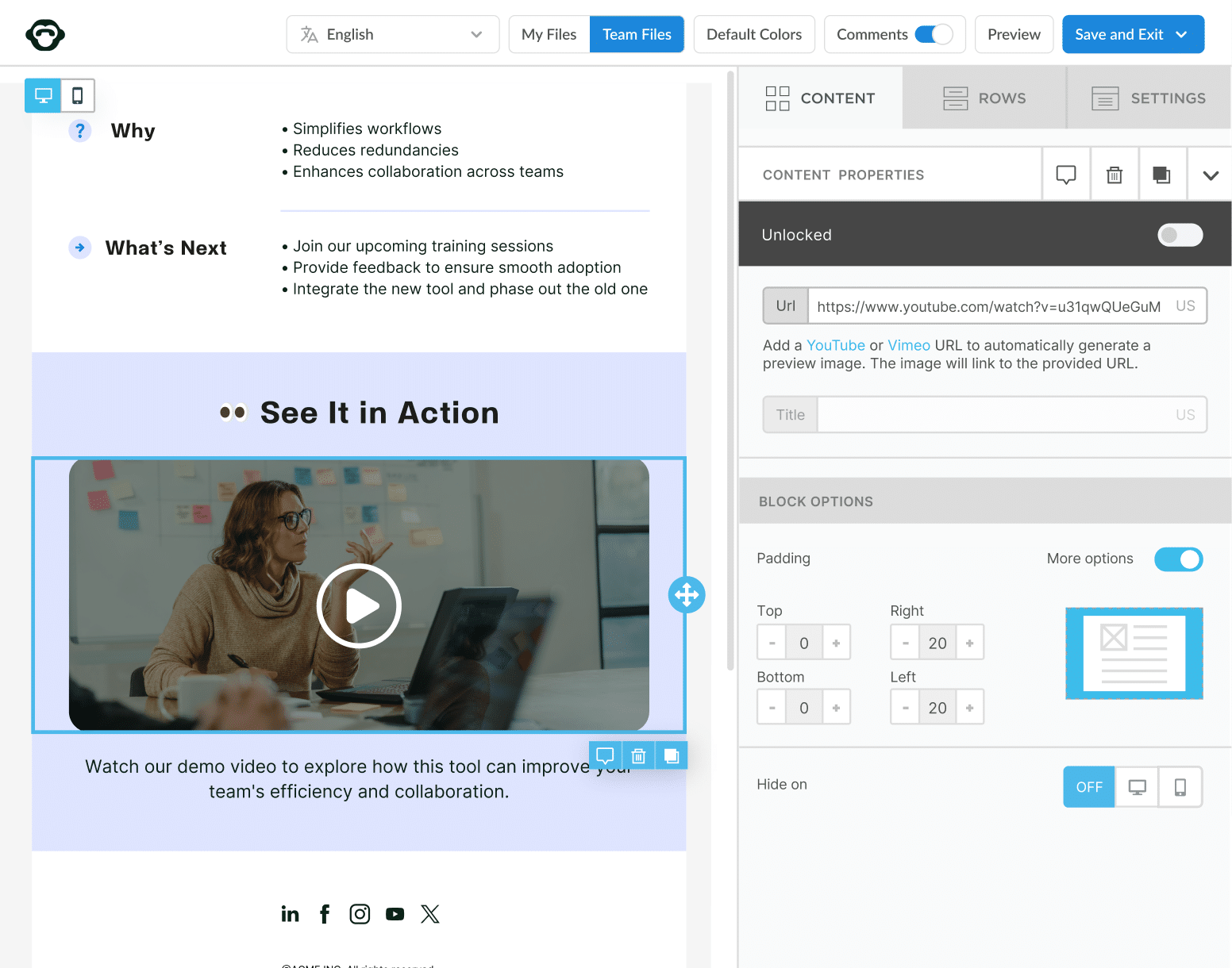
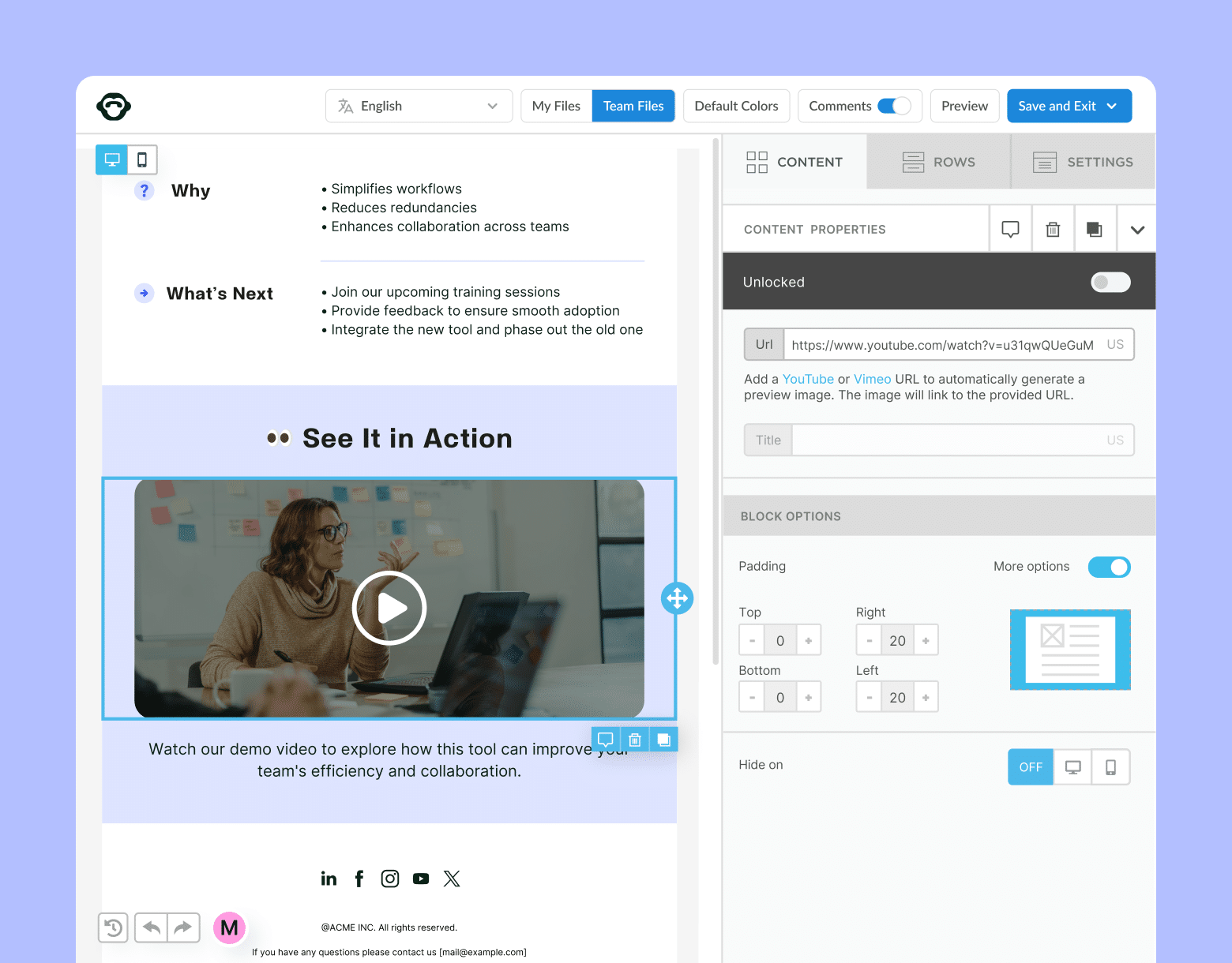
Why is Employee Engagement Important?
Engaged employees bring more energy to their work. They solve problems faster, collaborate more easily, and care about the outcomes. According to Gallup, organizations with high engagement levels report up to 18% higher profitability and 78% lower absenteeism.
Employee engagement is important because when teams feel supported and aligned, performance follows. Employee engagement creates the conditions for better decisions, a stronger culture, and long-term growth, no matter the industry or work model.
15 Employee Engagement Best Practices to Master in 2025
Employee engagement best practices are now a strategic priority, not an HR afterthought. Below are 15 practical, proven, and dare we say, refreshingly human ways to reignite connection in your workplace.
1. Ask better questions in your engagement surveys
You wouldn’t judge a first date with “On a scale of 1 to 10, how fun was this?” So why are we still asking employees to rate their entire experience in 10-question surveys twice a year? Engagement lives in the nuance. And that means asking employee engagement survey questions that go beyond satisfaction, and into storytelling.
Why this works to engage employees: When employees feel like they’re being listened to, not audited, they open up. Thoughtful questions invite thoughtful answers.
Why this works for the business: You get signal, not noise. Clear insights on how to improve—not just what needs improving.
Steps to execute:
- Ditch vague prompts like “Do you feel valued?” Instead, ask: “When was the last time you felt proud of your work here?”
- Use a mix of quantitative scales and open-ended questions.
- Use employee engagement software to analyze themes and trends.
Start two-way conversations and employee feedback loops
Learn how to engage staff with pulse surveys, content ratings and reactions, custom polls, and more. Ready to send modern emails?
See engagement features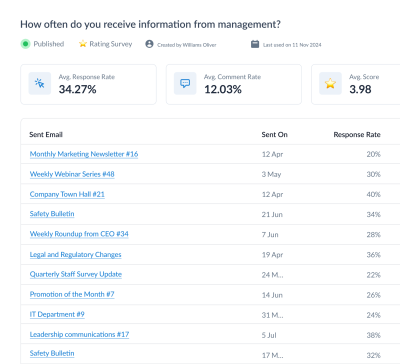
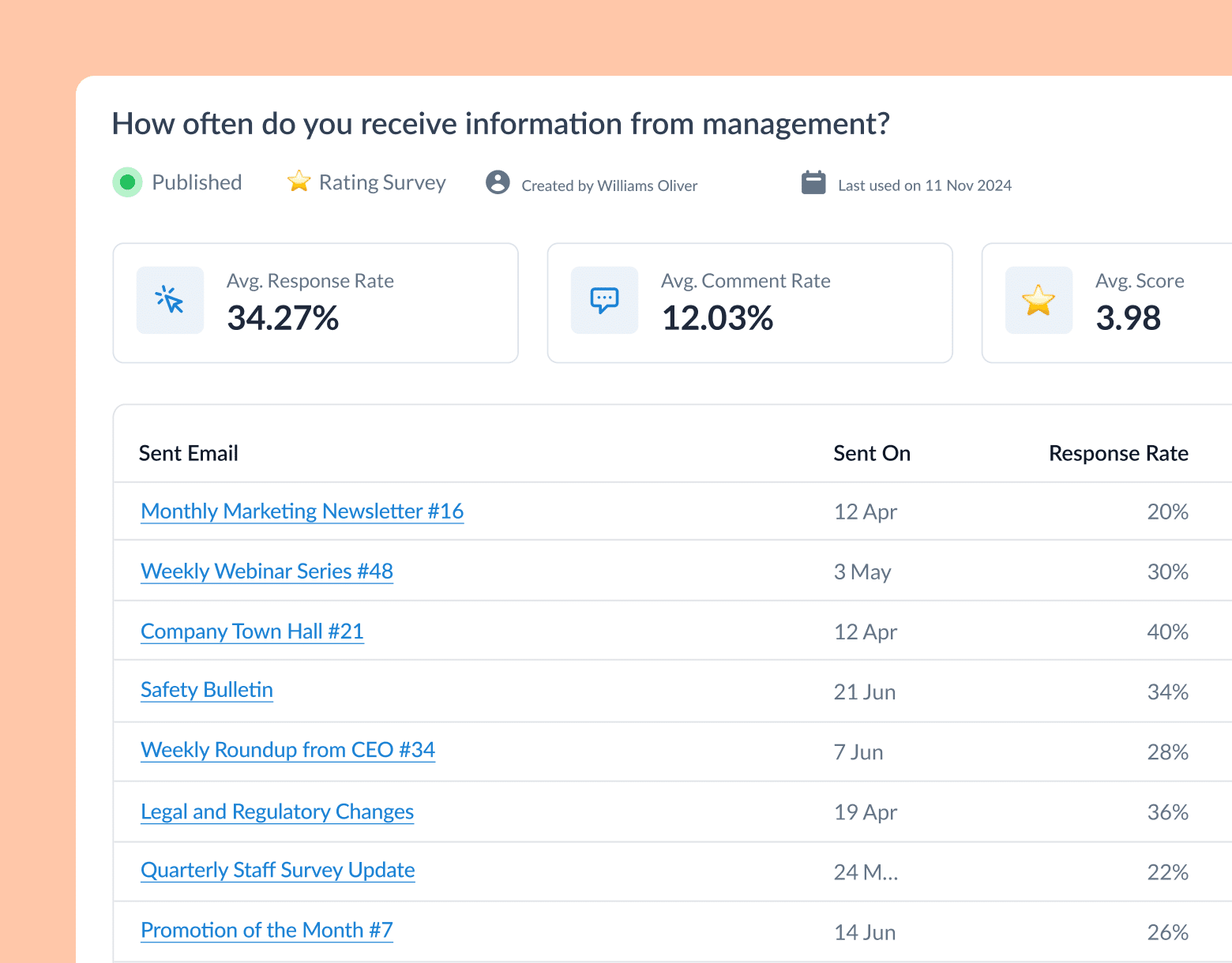
2. Make your managers the front line of engagement
People don’t leave jobs. They leave managers. Your managers are the most powerful engagement tool you have. Equip them—or risk losing your best people to bad middle management.
Why this works to engage employees: Managers shape the day-to-day experience. A weekly 1:1 with a thoughtful lead can turn a disengaged employee into your next brand champion.
Why this works for the business: Effective managers reduce turnover, boost team performance, and increase productivity. The ROI is real.
Steps to execute:
- Train managers in coaching, not only task management.
- Embed best practices for employee engagement surveys into their workflows.
- Give them pulse survey data to track team sentiment over time.
3. Turn feedback into action with employee engagement survey best practices
You’ve sent out the survey. Employees answered. Now what? If the next step is silence, you’ve just taught your people that their voices don’t matter. Following through is one of the most important employee engagement survey best practices. Acting on feedback builds credibility, trust, and momentum.
Why this works to engage employees: Employees feel heard. Even small changes based on feedback show that leadership is paying attention.
Why this works for the business: Taking action early prevents disengagement from festering. It also helps surface ideas and issues before they spiral into retention problems.
Steps to execute:
- After each employee engagement survey, summarize key insights in plain language.
- Communicate what actions are being taken—and when.
- Assign clear owners for each initiative and provide progress updates.
Create and send employee surveys for feedback
Engage staff with pulse surveys, eNPS surveys, reusable surveys, custom polls, and more. Ready to send modern emails?
Explore survey features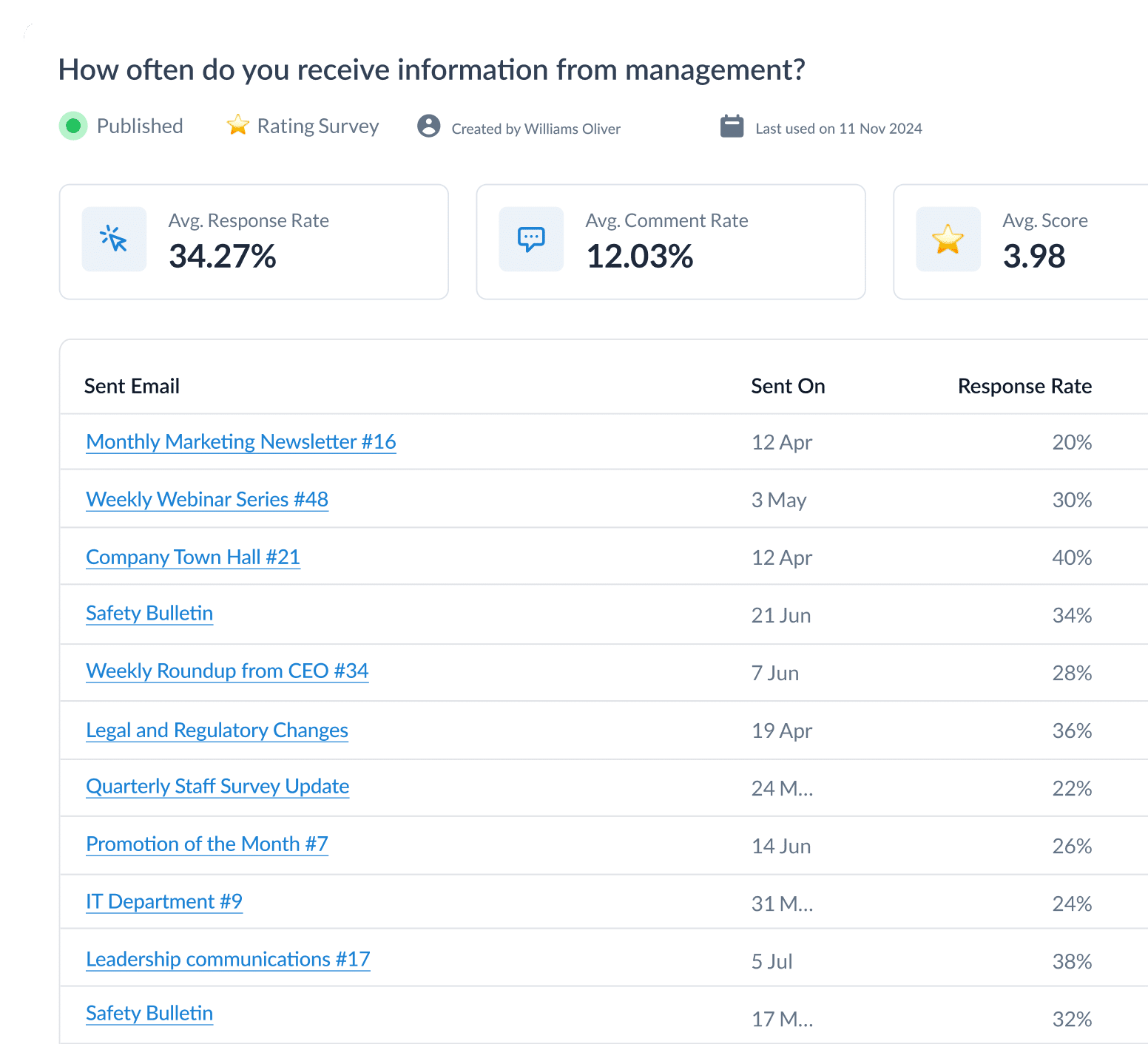

4. Recognize employees often
Recognition doesn’t need a plaque. A sincere, timely “thank you” can be just as powerful—and it’s one of the easiest best practices in employee engagement to implement. Make appreciation part of your culture, not only a quarterly task.
Why this works to engage employees: People want to know their work matters. Regular recognition increases morale, loyalty, and pride.
Why this works for the business: Companies that prioritize recognition see higher productivity and lower turnover. It’s a simple lever with big returns.
Steps to execute:
- Encourage managers and peers to call out great work in team meetings.
- Embed recognition tools into employee engagement software.
- Use these employee recognition ideas, celebrate wins in company-wide communications—big and small.
5. Foster a culture of open communication
Engagement doesn’t thrive in silence. It thrives in environments where employees feel safe to speak up—and confident they’ll be heard. A culture of open communication signals trust, respect, and alignment at every level.
Why this works to engage employees: When employees are kept in the loop and invited into the conversation, they feel valued. Transparency reduces uncertainty and increases emotional buy-in.
Why this works for the business: Clear communication improves decision-making, reduces confusion, and helps teams move in the same direction—faster.
Steps to execute:
- Host regular town halls with space for anonymous Q&A.
- Encourage leadership to share updates in plain language, not jargon.
- Use employee engagement surveys and pulse surveys to gather feedback continuously.
BONUS: Leverage these internal communication examples that drive engagement if you need more ideas for your IC practice.
6. Design and deploy a full onboarding program
First impressions matter. The way a company welcomes a new hire signals everything about how much they’re valued. Onboarding is your first chance to engage employees.
Why this works to engage employees: Thoughtful onboarding helps new employees build confidence, community, and purpose from day one.
Why this works for the business: Effective onboarding increases retention and accelerates productivity, saving money and morale.
Steps to execute:
- Create a structured, week-by-week digital employee onboarding plan.
- Introduce team rituals and culture early on.
- Pair new hires with onboarding buddies for informal guidance.
Unlock Internal Comms Superpowers
Discover why 10,000+ rely on us. See the internal email and employee newsletter platform in action.
Book demo

7. Share survey results transparently—then follow through
Trust doesn’t crumble from bad news, it crumbles from silence. Sharing the good, the bad, and the next steps is one of the most overlooked employee engagement survey best practices. Transparency builds alignment, and action builds belief.
Why this works to engage employees: When staff see employee engagement survey results and their feedback is acknowledged, they’re more likely to share openly and often.
Why this works for the business: Clarity and communication keep engagement efforts from stalling, and help leaders course-correct quickly.
Steps to execute:
- Use employee engagement software to compile key themes and data visualizations.
- Host a live or video recap from leadership within one week.
- Assign follow-up owners and create a feedback tracker.
8. Create meaningful connection moments to boost engagement
Engagement doesn’t just happen in all-hands meetings, it happens in hallway chats, Slack threads, and shared wins. Even in hybrid and remote environments, small connection moments go a long way.
Why this works to engage employees: People crave belonging. Rituals, recognition, and relationship-building fill that need.
Why this works for the business: Stronger connections reduce isolation, improve collaboration, and increase loyalty.
Steps to execute:
- Celebrate birthdays, milestones, and new hires with team-wide shoutouts.
- Host non-work virtual events like trivia or “coffee roulette.”
- Use pulse surveys to identify what kind of connection people want more of.
9. Send personalized internal emails that your employees actually want to open
When internal emails are relevant, well-timed, and targeted to the right people, they get read and acted on. It’s one of the most important best practices for employee engagement today.
Why this works to engage employees: Employees are more likely to engage with content that feels directly relevant to their role, team, or interests.
Why this works for the business: Personalized comms reduce email fatigue and increase participation in surveys, events, and initiatives.
Steps to execute:
- Use employee engagement software to segment your audience by location, department, or role.
- Leverage employee email templates tailored to different groups to save time.
- Track open rates and clicks to optimize your messages.
Get powerful email analytics and reporting features
Know exactly who is opening and engaging with your employee communications and company newsletters.
Explore analytics & reporting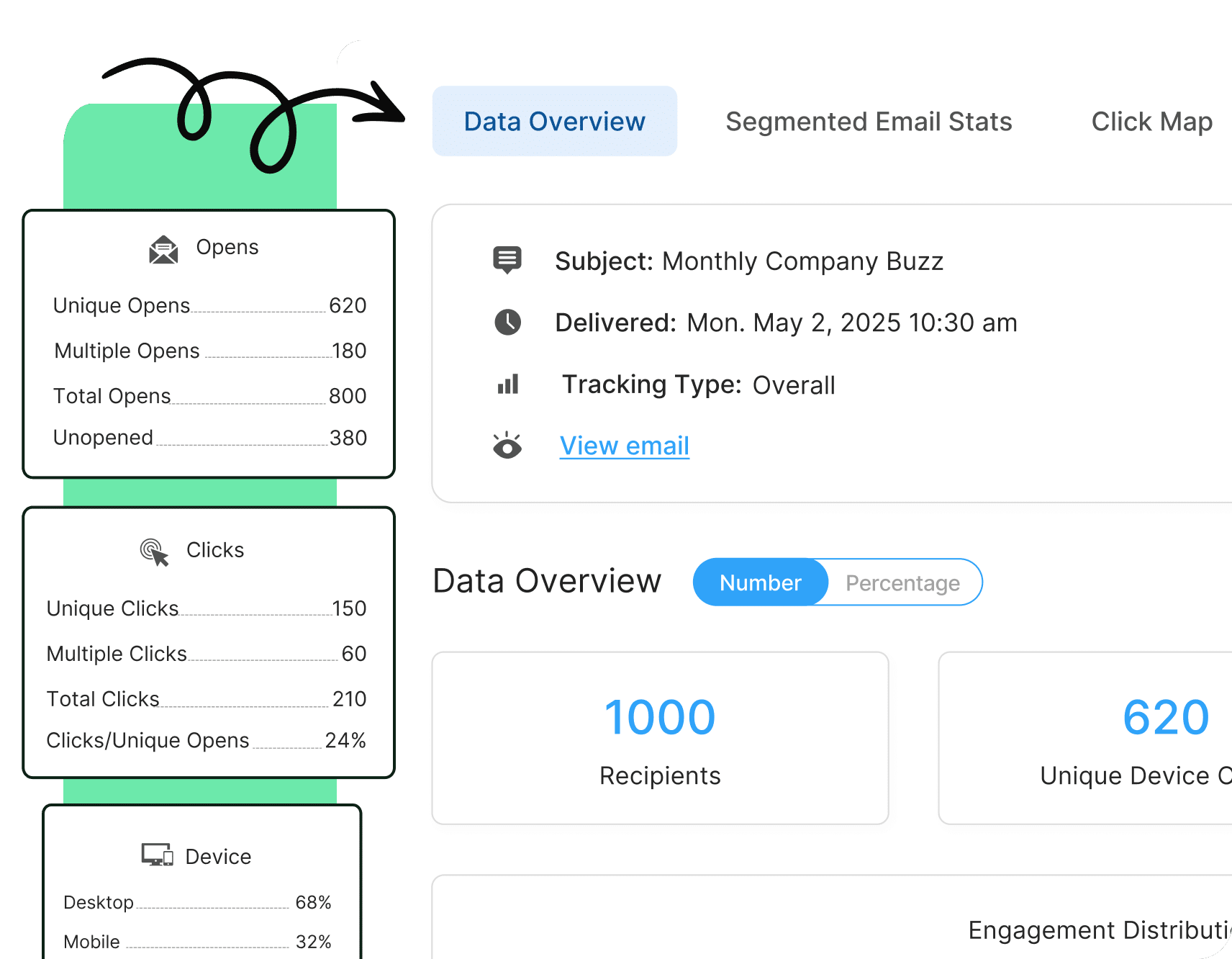
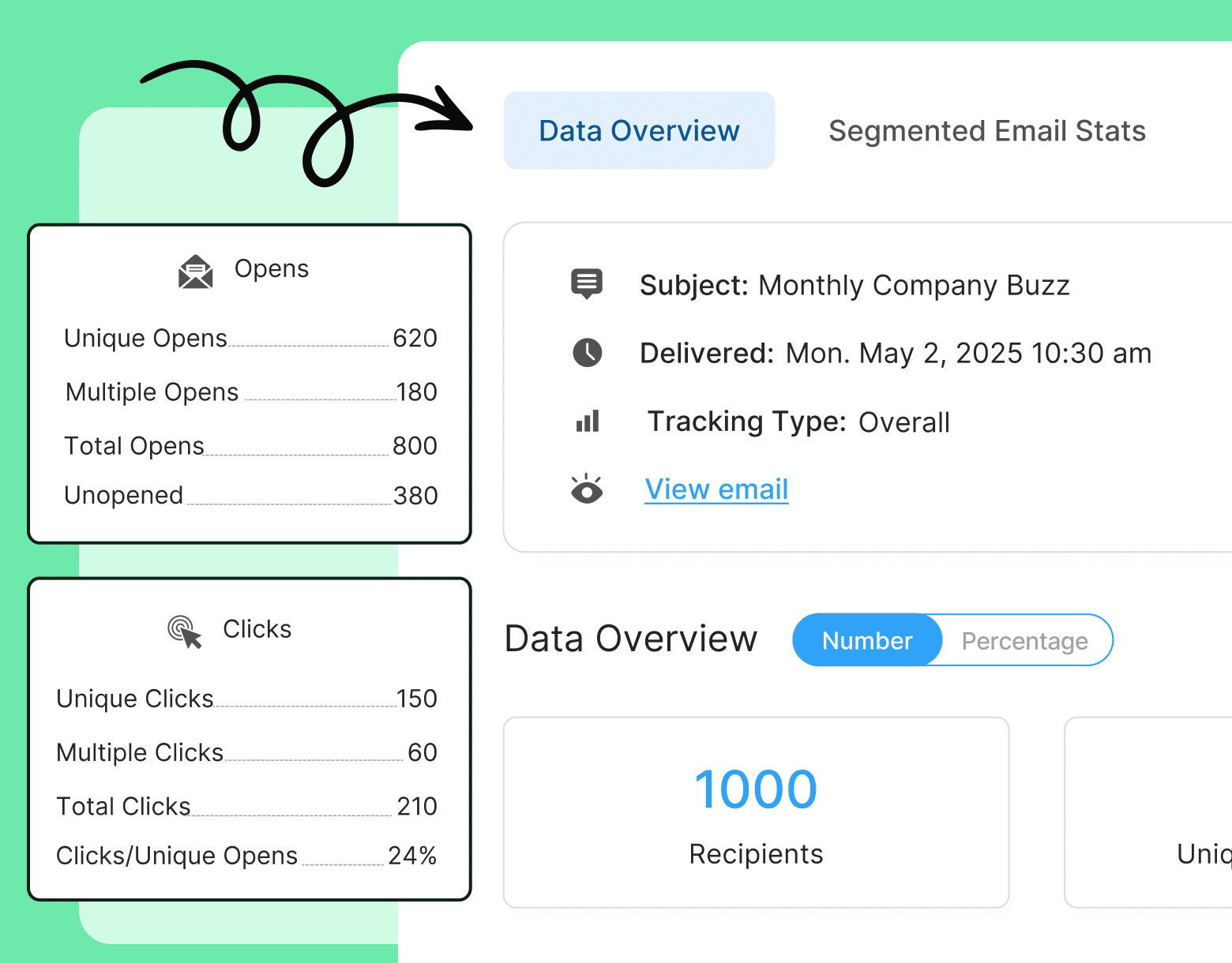
10. Link daily work to purpose for increased employee engagement
When employees know why their work matters, it stops feeling like busywork. This is one of the foundational employee engagement best practices.
Why this works to engage employees: People are wired for purpose. When work feels meaningful, engagement naturally increases.
Why this works for the business: Purpose-driven companies see higher productivity, better retention, and more innovation.
Steps to execute:
- Regularly share stories that show how employees’ work impacts customers or the community.
- Use leadership communication to connect tasks to company-wide goals.
- Build purpose into onboarding and performance reviews.
11. Use employee engagement software to gather real-time insights
Gut instinct has its place—but data tells you where to focus. Investing in tools that provide real-time metrics is one of the smartest best practices in employee engagement in 2025.
Why this works to engage employees: It shows you’re paying attention to what matters now—not what mattered last quarter.
Why this works for the business: Real-time data helps teams pivot fast, personalize strategies, and measure ROI from engagement initiatives.
Steps to execute:
- Choose an employee engagement software that integrates with your existing platforms (like Outlook or Gmail).
- Set up engagement dashboards that track opens, clicks, and survey participation.
- Share dashboards with leadership to inform decision-making.
12. Build two-way communication channels for honest feedback
Listening can go a long way when you’re developing employee engagement. Creating space for real dialogue and two-way communication is one of the most effective best practices for employee engagement.
Why this works to engage employees: When employees feel they have a voice, they feel respected and included. Engagement thrives in open, trusting environments.
Why this works for the business: Two-way communication fosters innovation, reduces blind spots, and creates faster alignment across teams.
Steps to execute:
- Implement always-on feedback channels like suggestion boxes or Slack threads.
- Encourage leaders to actively respond to comments in town halls.
- Use internal communications survey questions to follow up on real concerns.
Take a self-guided tour of ContactMonkey
See how our key features can streamline your internal communications.
Take product tour

13. Tie growth opportunities to your engagement strategy
People don’t just want to stay—they want to grow. One of the best practices in employee engagement is creating pathways for career development.
Why this works to engage employees: Employees who see a future at your company are more motivated to contribute today.
Why this works for the business: Upskilling and development reduce churn, boost innovation, and improve internal mobility.
Steps to execute:
- Include career planning as part of performance reviews.
- Promote learning stipends, mentorship programs, and certifications.
- Track learning activity with employee engagement software integrations.
14. Develop emotional intelligence across your organization
Consider how you communicate when building engagement. A key best practice in employee engagement is building emotional intelligence at every level, especially among leaders and people managers.
Why this works to engage employees: Employees feel safer, more understood, and more motivated when their leaders can empathize, regulate emotions, and handle conflict with care.
Why this works for the business: Teams with high emotional intelligence collaborate better, resolve issues faster, and maintain trust during change or pressure.
Steps to execute:
- Offer EQ training as part of your leadership development programs.
- Encourage managers to use emotionally intelligent check-in questions like “What support would be most helpful to you right now?”
- Model emotional intelligence in internal communications, especially during feedback or crisis messaging.
15. Replace annual surveys with continuous feedback loops
Waiting 12 months to check the temperature is an outdated practice. Today’s employee engagement survey best practices are built on continuous feedback, because engagement isn’t static, and your strategy shouldn’t be either.
Why this works to engage employees: Frequent check-ins show that feedback isn’t a formality—it’s how you run the business.
Why this works for the business: Pulse surveys provide timely data you can act on immediately, keeping your engagement strategy agile.
Steps to execute:
- Use employee engagement software to send monthly or quarterly pulse surveys.
- Keep surveys short—no more than 3–5 questions.
- Share the results quickly and follow up with targeted action.
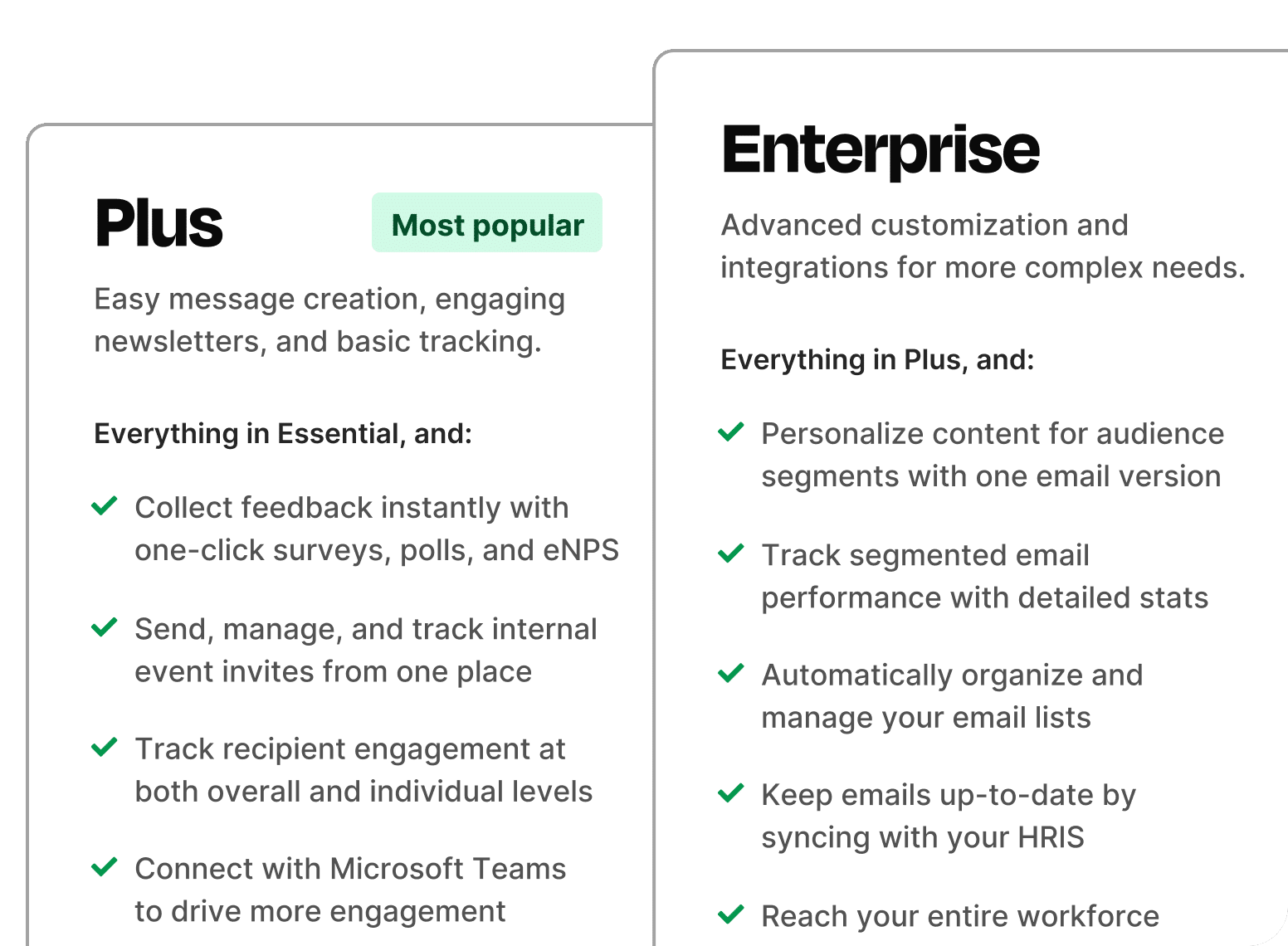
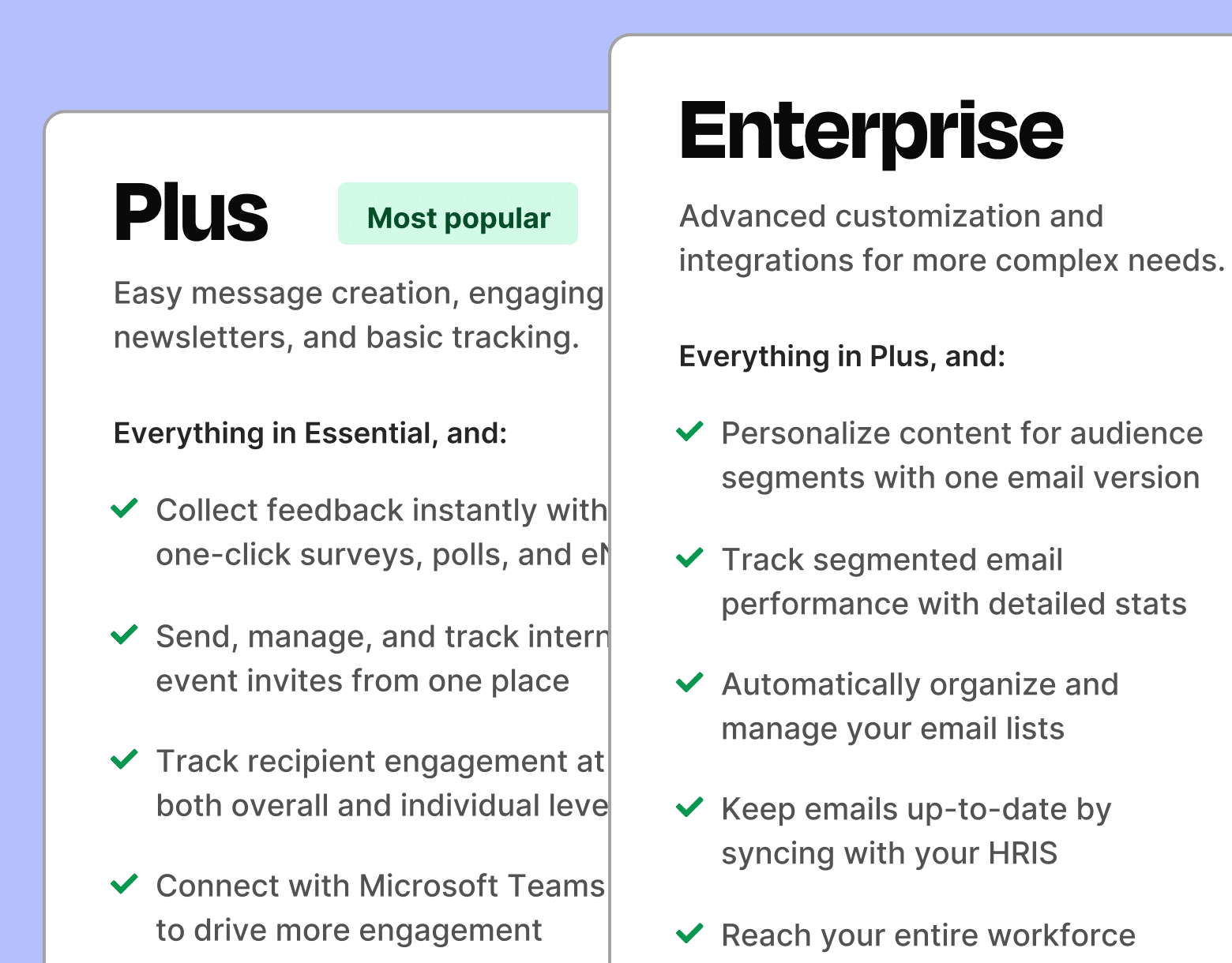
How ContactMonkey Can Help You Execute Employee Engagement Best Practices
Executing these employee engagement best practices takes the right tools. ContactMonkey’s internal communications software is built specifically for internal comms and HR teams who want to boost engagement with less friction and more insight.
Here’s how ContactMonkey helps you bring these best practices to life:
- Run smarter employee engagement surveys through Employee Feedback Features, with embedded pulse polls, star ratings, emoji feedback, and comment boxes—right inside your internal emails.
- Close the feedback loop faster with survey analytics, and comment heatmaps that show what matters most to employees—and where to take action.
- Personalize internal communications using Audience Segmentation Features, Dynamic Content blocks, and smart scheduling based on location or department.
- Track what’s working in real time through the Analytics Dashboard Feature, equipped with advanced email analytics like open rates, click maps, read time, and device type—directly inside Outlook and Gmail, thanks to integrations.
- Empower managers and leaders with easy-to-use email templates through the Email Template Builder Feature and engagement dashboards so they can lead more effectively.
Whether you’re just starting to improve your internal comms or you’re ready to scale engagement across a large enterprise, ContactMonkey gives you the data, flexibility, and support to make it happen. Book a 15-minute call with our specialists for more insights and to tour the platform!
